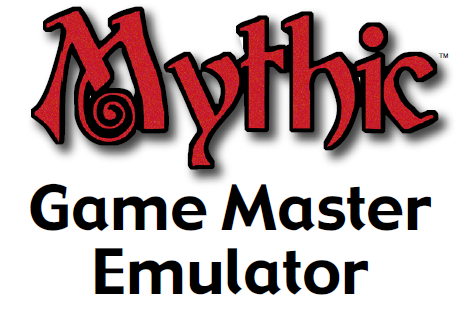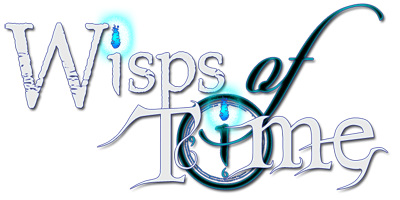Here’s our first step into the big leagues with the Mythic Game Master Emulator — the “gold standard” of solo engines — which I’ll be using alongside an old-school-inspired “sword & sorcery” game called Sharp Swords and Sinister Spells (Pay What You Want). Chapter 6 will be broken up into 3 parts: Mythic GME overview, SS&SS overview, and an Actual Play example putting the two together. If you’re only interested in the action, you can jump over to the actual play. If you don’t know what solo role-playing is, you may want to start with Chapter 1, which gives an introduction to the concept, and work your way up to this one (hopefully playing along with your own solo game!).
Mythic Game Master Emulator
I didn’t have to give too much thought to which solo engine I wanted to use. While there are plenty of excellent examples out there (and I’ve got a long list of them to try, of course), the one that seems to serve as the measuring stick is the Mythic Game Master Emulator by Tom Pigeon (there’s a “preview” PDF here). I did consider the Conjectural Roleplaying Gamemaster Emulator, commonly referred to as CRGE, by Zach Best (and if you can, please do go ahead and purchase this tool to support his family). A lot of folks prefer CRGE over the Mythic system, but I still felt like even the majority of those folks compare and contrast with the Mythic GME when they describe it, so there’s little choice but to learn Mythic if for no other reason than to comprehend what people are talking about when they mention Fate Questions, Chaos score, and Interrupt Scenes. I encourage you to read it, even if you never use it yourself, but not only for this reason — it’s full of great soloing advice in general.

Who needs a GM, anyway? You do, actually… you’re still the GM but now you have help.
Overview
Mythic Game Master Emulator is a tool that was originally included as the heart of the Mythic Roleplaying game (aka the “red” book), which termed itself a “no-preparation,” universal RPG that could be played by itself or alongside other games. The Game Master Emulator portions were later extracted as a separate product, minus the role-playing system, for a reduced price (the “blue” book). You could, of course, purchase either one and still get the GME content.
The GME aims to replace (or aid) your friendly local flesh-and-blood Game Master with tables and die rolls to answer Yes/No questions, not unlike the simple d6 systems I’ve exemplified in the previous Chapters. Mythic, however, is not just a Magic 8-Ball, it really steps things up a notch, not only in providing those answers, but also in influencing the results, guiding and altering your game to varying degrees as events unfold. The price you pay for this is the added complexity and upkeep between events. GMs could, of course, use it as a tool to augment or even run their campaigns, in addition to a group of players or a soloist to play without a GM, and it can even serve as a writer’s aid.
Core Mechanics
The core of the system is the Fate Chart, which is essentially a table you reference when you ask a Yes/No “Fate” question of the engine. You first estimate the odds of a “yes” answer in natural language terms like “Impossible”, “50/50”, “Likely”, or “A Sure Thing”. Then, roll d100 (* see info box below), and consult the chart for your answer. The rules place a strong emphasis on logic and interpretation of these results — there’s even a blurb on Sherlock Holmes and inductive vs deductive reasoning — which requires both improvisation and creativity. If any of that scares you, don’t worry: it all comes with practice.
Unlike the d6 systems we’ve used thus far, we’re actually influencing the results ourselves to a degree with the “odds” we indicate (and obviously, we can phrase questions to our benefit as well, but cheating is no fun), so stay true to yourself here and give odds objectively. Luckily, a portion of this is completely out of our control, and our degree of control is even reflected in the mechanics as the odds are influenced by the Chaos score: a number scale from 1 to 9, starting at 5, which increases as action occurs and decreases when our characters are more in control. A higher Chaos value gives a greater likelihood of a “yes” result, and thus can quickly conflagrate things further out of control.
We cross-reference our odds on the Fate Chart with the Chaos score to get the target number for our percentile roll — within the range is a “yes”, above it is a “no”. A result in the upper 20% of a No or lower 20% of a Yes indicates an “exceptional” response with a powerful impact. The interesting thing about all of this is that “Impossible” odds can still succeed and “A Sure Thing” can fail. Don’t stop yourself from posing extreme questions or applying these odds, if they make logical sense within your story. The outcomes could be extraordinary!
Upkeep and Random Events
As I mentioned, the engine has its costs and upkeep, which are reflected in the way you structure your Mythic adventures and the “lists” you must maintain. This upkeep has its upside, though, through the introduction of random elements to your game. Random events in response to questions, as well as altering and inserting Scenes add spice to life and these are more readily triggered as the Chaos score rises. Random elements can tap into the two lists you maintain — a Character/NPC list and a “Threads” (story/quest) list — so it’s important to track these items as they come and go.
Generally, a Mythic adventure is framed by Scenes. You describe how the Scene should open beforehand, which is often based around the logical next step from the previous Scene, and then roll 1d10. If the result is within the Chaos score, the scene is modified. An odd number is an Altered Scene, where you would change the scene setup in consideration of the next logical thing that would result based on all that’s known in the adventure so far — feel free to ask Fate Questions to clarify. An even number indicates an Interrupt Scene where something totally unexpected happens, in which case you would generate a Random Event to consider as the cause for the interruption (you can go back to your initial setup for the following scene if it still makes sense).
Random Events are generated by rolling percentile dice on a Focus table, which gives it some direction (something good or bad happens to your character or an NPC, a new NPC is introduced, or something ambiguous occurs). A pair of follow-up percentile rolls define what happens in that direction by giving you a Subject and an Action: a two-word combo which is considered in light of the context of all that’s happened so far and interpreted by you as the logical resultant event.
A Random Event occurs based on an Interrupt Scene result, but can also be produced simply by asking questions on the Fate Chart! If you roll doubles on the Fate Chart, and the “single” digit is within the Chaos score (e.g. Chaos: 5, roll a 44 = random event), a random event occurs following the resolution of your question.
Summary
Mythic can all be a little overwhelming to take in at once. I like to read through a new set of rules with a notebook in hand and take succinct notes, finally summarizing the whole thing, or distinct logical units of it (must be the programmer in me) in a bulleted list, procedure, or algorithm (sort of like pseudo-code before programming). I then work through a super simple example while referencing my notes, rather than trying to dig back through the book (or worse, the PDF — or even worse the PDF… on my phone!). Writing it down helps to instill it into my memory, while having notes to reference I find to be much quicker than flipping through a book — and, like my Hero Kids GM Screen, it can sometimes lead to a useful tool for sharing! In fact, I’ve already mocked up a fun and hopefully useful tool for Mythic (stay tuned for that!).
The GME has a lot of parts to it, but it’s not terribly complicated overall. You can work out the procedure relatively simply from a pair of lists, below. A brief example follows, but there are numerous, more-detailed examples in the book, which I still recommend picking up.
Sequence of Play
- Set the Scene (what’s supposed to happen)
- Roll 1d10. If it’s within the Chaos score:
- Odd = Altered Scene (next most logical Scene from Step 1)
- Ask Fate Question(s) to clarify if it’s unclear.
- Even = Interrupt Scene (new/unexpected Scene and precludes Step 1)
- Random Event, it’s the reason for the new Scene.
- After Interrupt Scene, you can return to the original Scene from Step 1 if it’s still relevant
- Odd = Altered Scene (next most logical Scene from Step 1)
- Play! (repeat as needed, in no particular order, until logical Scene end)
- Describe how the Scene unfolds among all its characters and conflicts.
- Apply the mechanics from your game of choice as necessary.
- Ask Fate Questions:
- Pose a Yes/No question
- Determine Odds of “Yes”
- Cross-reference Odds by Chaos on Fate Chart for Target
- Roll 1d100 within Target = Yes. If single digit of a doubles roll within Chaos:
- Random Event, occurs following resolution of Question from Step 3.3.1
- End of Scene Upkeep
- +/-1 to Chaos based on action and success/control during Scene
- Add/Remove Characters and Threads from Lists
- If that doesn’t conclude the adventure, go back to Step 1
Random Events
- Roll 1d100 on:
- Event Focus table
- Event Meaning: Action & Subject tables
- Interpret the logical Random Event
The Super Simple Example
(1. Set the Scene) It was a dark and stormy night (*chuckles*)… the power has just gone out, but as Carson watches the heavy rain through his large bay window, he notices the lights are on at a place several houses down and across the street. The rest of the neighborhood is blacked out as far as he can see. (Note: you may recognize this as roughly the plot for the movie Coherence — but discard your expectations and premonitions as we let the GME “tell” the story).
(2. Roll 1d10 for Scene Mod) Result: 9 – no change to scene.
(3. Play!) (3.1 Describe…) Curious as usual, Carson dons his rain coat and rubber galoshes, grabs a flashlight, and makes his way outside. The rain slows to a depressing drizzle as he starts down the street towards the house with the lights on. He pauses at a 4-way intersection two doors away from the place and gives a listen, expecting to hear the sounds of a running generator.
(3.3 Ask Fate Questions) [Does he hear a generator? Chaos: 5, Odds: Very Likely (Probability: 85%) — Result: 44 = Yes, he does hear a generator and a random event occurs!]
(3.3.4.1 Doubles within Chaos = Random Event) [1d100 on Random Event tables: Focus: 61 – PC Negative, Action: 51 – Overindulge, Subject: 2 – Dreams] I interpret this result to mean Carson is distracted while indulging in a fantasy, allowing something unfortunate to happen:
(3.1 Describe…) Sure enough, the muffled hum of a generator motor can be heard above the patter of light rain. He starts walking towards the place again, wondering if anyone might be around to chat for a few moments about the passing storm, the power outage, or even the make and model of that generator. As he steps through the intersection, he notices movement from one of the lighted upstairs windows of the house. He’s stopped in his tracks… It’s her!
He’d first noticed the woman about three weeks ago while having his morning cup of coffee by the front bay window, as he always did. Fit and very shapely, the 30-something young lady must be new to the neighborhood — and a religious runner, passing on the sidewalk in front of his house at nearly the exact same time, 3 days a week.
She floated from the unshuttered window to one covered by a blind. Her silhouetted movements drew Carson’s imagination in uncontrollably. His senses tuned to her every motion, it was not until the last moment before he was struck that he heard the blaring horn and squeal of tires.
(3.2 Game mechanics) [<insert mechanics for his injury here>] His arm is broken and he’s suffered a concussion.
(3.3 Ask Fate Questions) [Does he remain conscious? Chaos: 5, Odds: No Way (Probability: 15%) — Result: 86 = Exceptional No! Not only does he lose consciousness, but he suffers amnesia as well.]
(4. End of Scene Upkeep) Chaos: +1; Characters: +The girl, +The driver; Threads: The main thread could stand as investigating the lighted house or his injury/amnesia might very well take precedence. Side threads could be added for his interest in the girl and discovering who ran him over. Or if you wanted to add some humor, finding out the make and model of that generator!
Rinse & Repeat!
At this point, you’d go back to Step 1 and set up the second scene. Does he awake alone in the hospital, not knowing his own name? Perhaps the scene is altered and the driver is there with him, apologetic and hoping to avoid a lawsuit. An Interrupt Scene could introduce the girl’s heartthrob paramedic boyfriend. You get the idea, and as always, it’s up to you!
Hopefully this serves as a fair example of using Mythic and how it can quickly introduce surprise and excite you, getting those mental gears spinning so hard you might struggle to reel it in (later on, we’ll take a look at some frameworks to help with boundaries).
I’ve only read the “blue book” Mythic Game Master Emulator version, so I can’t comment on what all goes into the universal RPG elements of the “red book” (there’s also an orange-ish book called Mythic Variations with optional rules and more tips which may be worth checking out). While I hope the above serves as a good overview for what the GME is and roughly how it works, you’d be doing yourself a disservice by not reading through the book on your own. There’s much greater detail, tons of examples, and lots of tips and tricks to go with it all.
One final tidbit I will mention though, Mythic states that these are all “suggestions” and not rules. They also specifically give you the “I dunno” rule, which in essence means: when in doubt, throw it out. Don’t spend too much time contemplating things, just go with the first logical thing that comes along to keep your game from becoming bogged down in thought exercises. It’s all about having fun on your own terms, so do what’s right for you!
Next up in Part II , we’ll look at the Shard Swords & Sinister Spells OSR-inspired RPG rules.







Comments are closed.